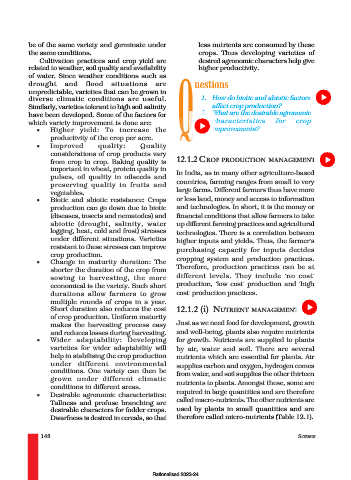Page 154 - Understanding NCERT Science 09
P. 154
be of the same variety and germinate under less nutrients are consumed by these
the same conditions. crops. Thus developing varieties of
Cultivation practices and crop yield are desired agronomic characters help give
related to weather, soil quality and availability higher productivity.
of water. Since weather conditions such as
Higher yield: To increase the Q
drought and flood situations are uestions
unpredictable, varieties that can be grown in
diverse climatic conditions are useful. 1. How do biotic and abiotic factors
Similarly, varieties tolerant to high soil salinity affect crop production?
have been developed. Some of the factors for 2. What are the desirable agronomic
which variety improvement is done are: characteristics for crop
• improvements?
productivity of the crop per acre.
• Improved quality: Quality
considerations of crop products vary
from crop to crop. Baking quality is 12.1.2 CROP PRODUCTION MANAGEMENT
important in wheat, protein quality in In India, as in many other agriculture-based
pulses, oil quality in oilseeds and
preserving quality in fruits and countries, farming ranges from small to very
vegetables. large farms. Different farmers thus have more
• Biotic and abiotic resistance: Crops or less land, money and access to information
production can go down due to biotic and technologies. In short, it is the money or
(diseases, insects and nematodes) and financial conditions that allow farmers to take
abiotic (drought, salinity, water up different farming practices and agricultural
logging, heat, cold and frost) stresses technologies. There is a correlation between
under different situations. Varieties higher inputs and yields. Thus, the farmer’s
resistant to these stresses can improve purchasing capacity for inputs decides
crop production. cropping system and production practices.
• Change in maturity duration: The
Therefore, production practices can be at
shorter the duration of the crop from
sowing to harvesting, the more different levels. They include ‘no cost’
economical is the variety. Such short production, ‘low cost’ production and ‘high
durations allow farmers to grow cost’ production practices.
multiple rounds of crops in a year.
Short duration also reduces the cost 12.1.2 (i) NUTRIENT MANAGEMENT
of crop production. Uniform maturity
makes the harvesting process easy Just as we need food for development, growth
and reduces losses during harvesting. and well-being, plants also require nutrients
• Wider adaptability: Developing for growth. Nutrients are supplied to plants
varieties for wider adaptability will by air, water and soil. There are several
help in stabilising the crop production nutrients which are essential for plants. Air
under different environmental supplies carbon and oxygen, hydrogen comes
conditions. One variety can then be from water, and soil supplies the other thirteen
grown under different climatic nutrients to plants. Amongst these, some are
conditions in different areas.
• Desirable agronomic characteristics: required in large quantities and are therefore
Tallness and profuse branching are called macro-nutrients. The other nutrients are
desirable characters for fodder crops. used by plants in small quantities and are
Dwarfness is desired in cereals, so that therefore called micro-nutrients (Table 12.1).
142 SCIENCE
Rationalised 2023-24

